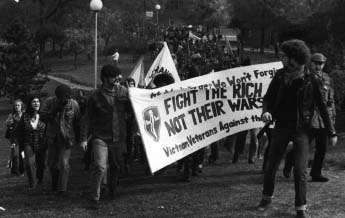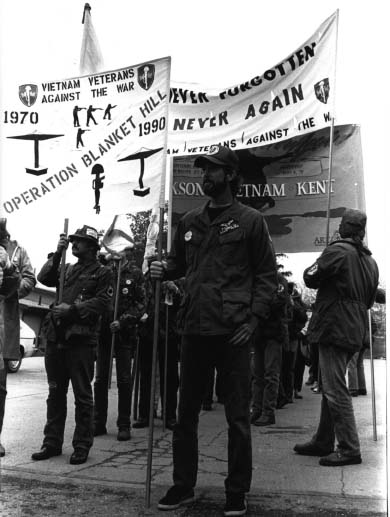 Download PDF of this full issue: v29n2.pdf (11.4 MB)
Download PDF of this full issue: v29n2.pdf (11.4 MB)From Vietnam Veterans Against the War, http://www.vvaw.org/veteran/article/?id=153
 Download PDF of this full issue: v29n2.pdf (11.4 MB) Download PDF of this full issue: v29n2.pdf (11.4 MB) |
"As the Ohio law says, use any force that's necessary, even to the point of shooting. We don't want to get into that, but the law says we can if necessary."
- Major General Sylvester Del Corso at a press conference, May 3, 1970
On April 30, 1970, Richard Nixon doubled back on his promise to end the war in Vietnam by expanding the visible conflict and invading Cambodia, a neutral country. The American people, visibly tired of the ongoing conflict, reacted against the expansion of the war. Still unaware of the massive secret bombings of Laos and Cambodia, the anti-war movement reacted strongly to this new expansion. College campuses across the country were at the forefront of these actions.
The political mood in Ohio and the events leading up to Kent State mirrored those of the nation. Labor unrest, civil rights struggles, and anti-war activities simmered and then boiled over in the spring of 1970.
In Cincinnati, Cleveland, and Columbus, the African-American communities fought for recognition, and the International Brotherhood of Teamsters called a statewide strike against the trucking industry, then went on to brutally punish the Ohio National Guard for interceding on behalf of trucking concerns. In Columbus, Ohio State University, on the day of its one hundredth anniversary, was plunged into two weeks of violent street fighting when Ohio State police and Columbus city police attacked a peaceful demonstration at the gates of the university. The students were asking for black studies programs and an end to the war. Before the university was closed for the balance of the spring term, hundreds of students and community residents were wounded and injured in the fighting that raged before and after the events at Kent State. Before the second week in May, every major college or university in Ohio was closed and occupied by police and National Guard forces.

By late April, Kent, Ohio, a small college town in northern Ohio, had begun to stir politically. With many students gone for the first weekend in May, student activists on campus pressed forward protesting the war. Off campus, some students and "townies" confronted police, and went on a trashing binge in the bar district on the evening of May 1. Though unrelated to any movement political activities on campus, the mayor of Kent, Leroy Satron, contacted Ohio governor Rhodes, requesting that National Guard forces be sent and stating that SDS (Students for a Democratic Society) had taken control of a part of the city of Kent. With absolutely no basis in fact, forces yet unseen had been set in motion.
By May 2, elements of the Ohio National Guard, Troop G of the 2nd Company, 107th Armored Cavalry and companies A&C of the 145th Infantry Regiment had arrived in Kent. They entered the campus area of Kent State University without authorization, following the burning of the ROTC building on the same evening. Subsequent investigation of the fire by the authorities failed to place any blame on a specific group, student or otherwise. The university at no time requested the presence of the National Guard and later investigation revealed that the Portage County Sheriff's Department and the Ohio State Police felt that there was no overt threat on campus.
The Ohio National Guard units brought to Kent had problems of their own. Fresh from the teamster strike in the Cleveland area, these particular guardsmen were battered, beaten and exhausted. Ironically, fresh Guard units, specially trained for riot duty, were stationed nearby, sitting unused.
The day and evening of May 3 saw an escalating spiral of violence as the Guard units began to teargas and bayonet groups of students whenever they tried to gather. Addressing the assembled Guard troops that evening, Governor Rhodes took the stage, saying, "No one is safe in Portage County. It is just that simple. No one is safe, and I do not believe that people understand the seriousness of these individuals who are organized in a revolutionary frame of mind." Coupled with earlier statements of National Guard officers promising an armed response to student demonstrations, the stage was set for the tragic events of May 4.
After a morning filled with confrontation and Guard marches, the fatal events unfolded. At 12:24 P.M., a group of guardsmen marched up Blanket Hill near Taylor Hall, turned in an orderly line, raised their weapons and fired on the students, some as far away as 390 feet. When the firing stopped, four students lay dead: Jeff Miller, Allison Krause, Bill Schroeder, and Sandy Scheuer. Thirteen others were wounded, several so severely that they are disabled to this day.
The national outcry against these shootings brought massive demonstrations around the country, closing hundreds of colleges and universities, and culminating in giant anti-war marches on both coasts. The intention to stifle the student movement had backfired, energizing it further. Ohio politicians moved to cover up the murders. Indictments were brought against the wounded students, charging them with responsibility for the events. Subsequent investigations by the FBI and the Justice Department, while hardly sympathetic to the students, clearly pointed the finger of guilt at the guardsmen, their officers, and the governor. The Ohio government moved as quickly as possible to stage a grand jury, pre-empting any federal jury of the same type, with the full cooperation of the Nixon administration. The guilty walked.
Ten days after the Kent State shootings, Mississippi state police shot two students to death at Jackson State University in South Carolina. Turning from the black communities and inner cities across the country, brute force and legalized murder became the order of the day on campus as well. Using the Law Enforcement Assistance Act (LEAA), Nixon handed out billions of dollars to police forces everywhere, arming them with weapons developed for the war in Indochina and creating an instant network of paramilitary forces, in effect a national police force. Vice President Spiro T. Agnew proudly proclaimed, "We have buried the student movement in the U.S." Nothing could have been further from the truth.
The anti-war and minority rights movements were unbowed and grew stronger from the experiences. The decade that followed included year after year of rallies and demonstrations at Kent State. The Ohio State Police assumed the role of the heavies, beating, bashing and gassing participants year after year. We in VVAW were always there. The "Struggle to Stop The Gym," which was to be built on the spot where the students died, was the scene of particularly vicious attacks by the university and state police. Fortunately, as time has passed, the annual events at Kent have drawn a much more reasonable response from the university. The 15th, 20th and 25th commemorations have gone easier.
Thanks to the unflagging commitment and support of the Kent State students, the programs have continued over the years. VVAW has kept its commitment to help keep the spirit of Kent State alive over the years. Beginning in 1970, when vets founded the Kent Chapter of VVAW, up to the present, we have seen the importance of remembering the events of Kent State 1970 for the student movement of today. Please join with us in supporting the students of KSU at the 30th anniversary of the shootings at Kent State on May 4, 2000.
Bill Davis is a Vietnam vet and former US Air Force Staff Sgt.
Davis has been a member of VVAW for 30 years.
For more information about the VVAW contingent at the Kent State 30th Anniversary, contact the VVAW National Office at (773)-327-5756 or e-mail <vvaw@vvaw.org>.
